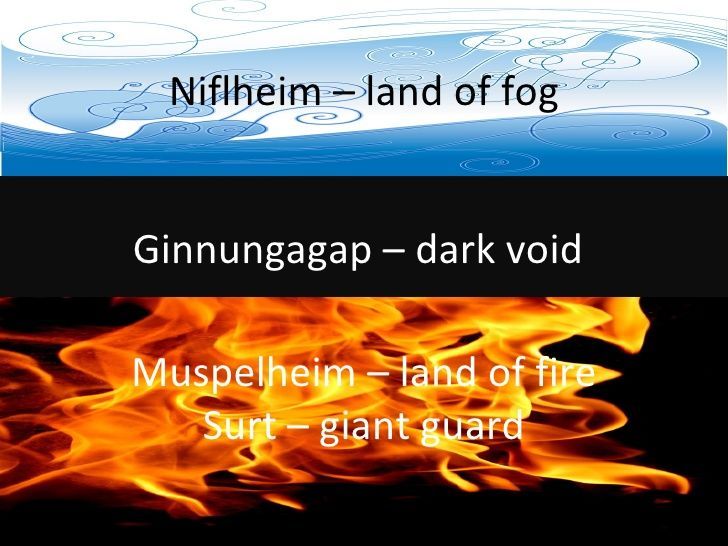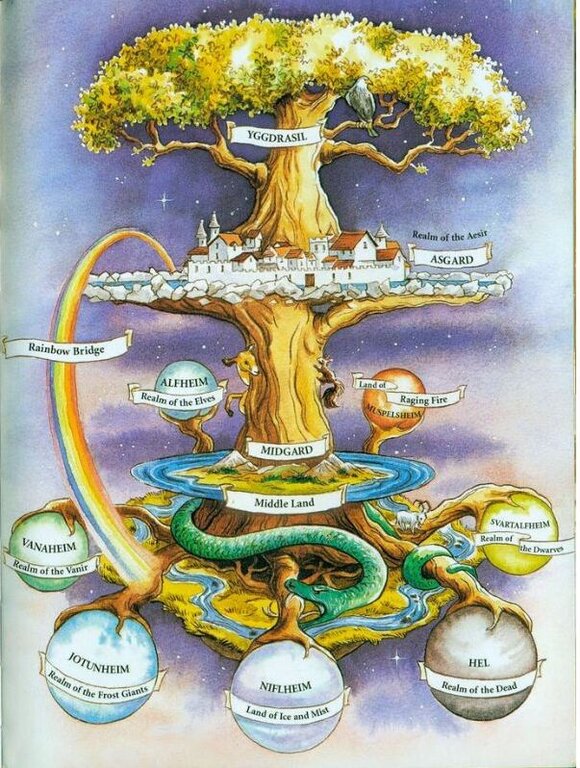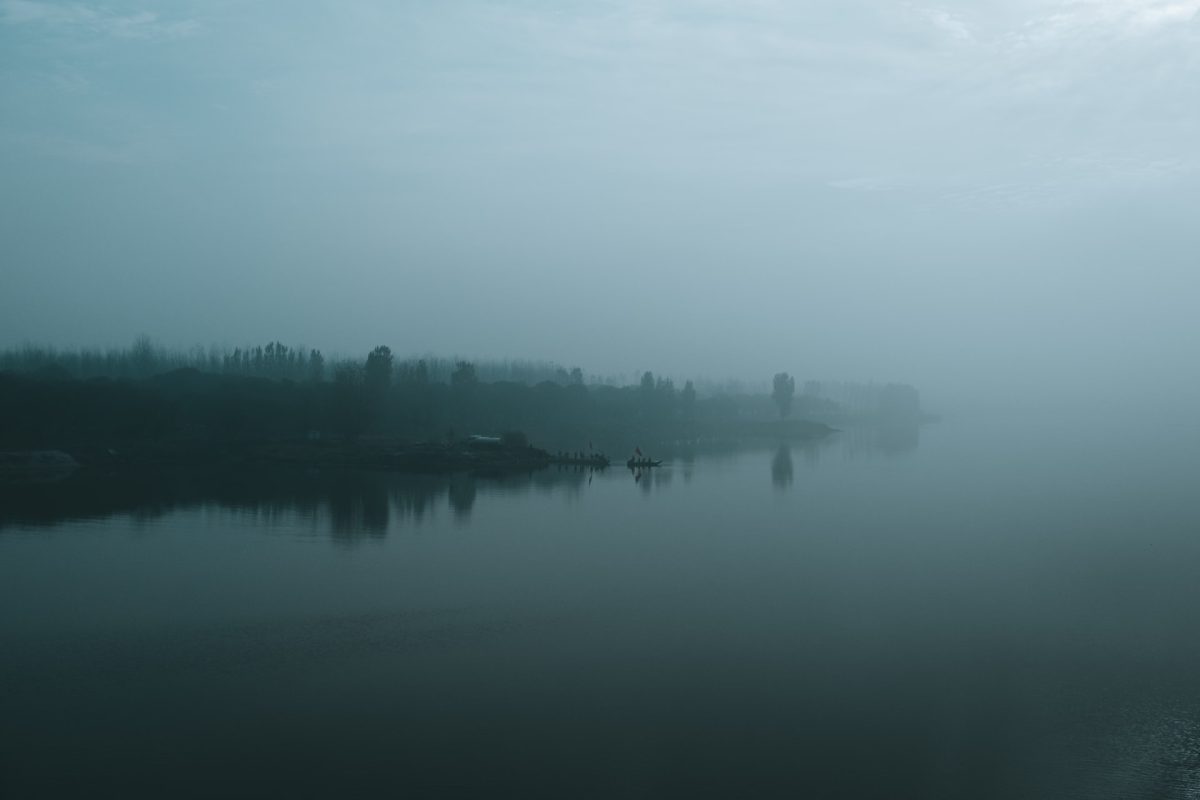In Norse mythology, Niflheim was the freezing, dark, and misty world of the dead, ruled over by the goddess Hel.
Norse mythology dictates nine realms sit in the branches or the roots of Yggdrasil, the world tree. Of these nine, six are constant and feature in every image or description of the realms: Asgard, Alfheim, Vanaheim, Midgard, Jotunheim, and Muspelheim.
The other three are a selection of Svartalfheim and Niðavellir or Hel and Niflheim. Svartalfheim and Niðavellir are sometimes combined, as are Hel (Helheim) and Niflheim.
Niflheim meaning
In Old Norse cosmology, Niflheim or Niflheimr means “World” or “Home of Mist.”
The Islandic word for“mist” is nifl and is a linguistic cognate to the Old English word nifol (“dark” or “gloomy”), the Middle Dutch nevel, the Old High German nebul (“fog”), and the Ancient Greek νεφέλη (“cloud”).
What is Niflheim in Norse Mythology?
In Norse mythology, Niflheim was the freezing, dark, and misty world of the dead, ruled over by the goddess Hel. Niflheim and Muspelheim originate from Ginnungagap (the “yawning void” or “gaping abyss”).
Any search for the ruler of Niflheim only produces the name Hel so there is no obvious answer to who the ruler was, which might hint the two realms are the same.
Vafthrúdnismál, the third poem in the 13th-century collection of Old Norse poems, the Poetic Edda, tells how the rivers of Ginnungagap that existed at the beginning of the world were called the Élivágar (Old Norse: “Ice Waves”). They contained eitr (described as poisonous yeast), a liquid that is the source of all living things. The water broke the banks of the rivers and froze, spreading over the land.

There is a contradiction here: the verses also mention rain, which is strange for such a cold place, but we will have to put that down to artistic license on Sturluson’s part!
The poisonous ice extended towards the lands and fire giants of Muspelheim, started melting and dripping, and formed Ymir, the first frost giant.
The Creation of Niflheim
Niflheim and Muspelheim were the first lands to be created in Norse Mythology. Niflheim sat north of the void of Ginnungagap.
“It was many ages before the earth was shaped that Niflheim was made,” says the Gylfaginning from the Prose Edda, a 13th-century collection of texts based on Old Norse mythology by the Islandic poet, writer, and historian Snorri Sturluson.
Norse myth tells that the commencement of life was all about ice, Niflheim, and fire, Muspelheim.
When the icy cold air of Niflheim met the warm currents of air from Muspelheim, the poisonous life-fluid Eitr began to drip on the land and formed Ymir the jötunn and the ice cow Audhumla.
Is Niflheim the Underworld?
Niflheim is the underworld because it lies at the bottom of the World Tree, Yggdrasil.
Are Niflheim and Helheim the Same?
There is no clear answer to this question in any literature available. We can only use translated sections of literature or poetry to try and gain some insight.
Read our in-depth article analyzing the available literature on this particular topic.
Places Found In Niflheim
Niflheim contains the land of Hel (or Helheim). Hel was the land of the afterlife for those who died of natural causes in Norse mythology.
Valhalla, in turn, was the land of warriors who met a glorious end in battle. It lay at the bottom of the world in or near Niflheim.
Odin appointed Hel (or Hela in “Thor: Ragnarök”), the daughter of Loki, as its ruler. She is wrongly depicted as the daughter of Odin and the brother of Thor and Loki in the movie “Thor: Ragnrok”.
The Poetic Edda describes how Brunhilde travels to Hel after committing suicide (or is killed; the sources differ) over the death of her love Siegfried.
Odin rides to Hel on his eight-legged Sleipnir. The Prose Edda also tells how Odin’s son, Hermóðr, attempted to retrieve Baldr from the underworld, aided by Sleipnir.

Creatures Found In Niflheim
Niflheim was home to Ymir, the jötunn, and the primeval ice cow Auðumbla (or Audhumla).
Odin’s grandfather, Búril, owed his existence to this ice cow that Ymir suckled on. Auðumbla liked to lick salty rime stone encased in ice, and this gradually melted, uncovering Búri, who came to life!
The Gylfaginning from the Prose Edda describes how Ymir fed on the cow’s teats, which produced four rivers of milk.
Why does Odin Visit Niflheim and Kill Yimir?
To kill Yimir.
The sons of Bor Burison, Odin, Vili, and Vé created Midgard using the remains of the frost giant Ymir. Ymir was the oldest being in the whole of Norse myth and lived in the primordial void called Ginnungagap.
The reasons for them deciding to kill him are not clear.
Some claim they merely wanted a giant being to provide enough material to create a world. Others believe that Ymir’s antics, such as giving birth from his armpits and producing a six-headed being from between his legs, annoyed the gods enough to want him killed. Another version is that they believed Ymir to be too much of a threat to the realms.
Odin killed the giant with his spear. So much blood poured from the wound it drowned all the jötnar except for Bergelmir and his wife. They escaped in a hollowed-out log and were responsible for the subsequent repopulation of the giants in Jotunheim.
Ymir’s flesh and blood (and, in some accounts, worms) also created the race of dwarves.
Why is the Goddess Hel the ruler of Niflheim?
In the Gylfaginning, Gylfi also hears that Loki fathered the goddess Hel. Odin cast her into Niflheim and awards her power over the nine worlds, gathering everyone who died of sickness or old age.
However, Valhalla was the realm of warriors who had died a glorious death in battle.

